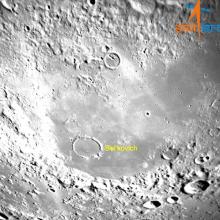Listen to today's episode of StarDate on the web the same day it airs in high-quality streaming audio without any extra ads or announcements. Choose a $8 one-month pass, or listen every day for a year for just $30.
You are here
Moon and Spica
Like a cruise ship that makes a regular circuit of stops, the Moon has a regular program of ports of call. It passes by the same stars every month, on a schedule that’s easy to predict — no delays for bad weather or virus outbreaks.
And the Moon is paying call on one of those destinations tonight: Spica, the brightest star of the constellation Virgo. Spica is below or to the lower right of the Moon as they climb into good view, after midnight, and closer to the Moon at first light.
The Moon visits the same array of stars because they all line up near the ecliptic — the Sun’s path across the sky. The Moon stays close to the ecliptic as well — it never moves more than a few degrees to either side of it. So during the Moon’s travels, it returns to these same stars over and over.
It visits each star every 27 and a third days. But the Moon’s cycle of phases is a couple of days longer than that, so it’s not at the same phase from one visit to the next. Tonight, for example, the Moon is about 21 days “old” — it’s 21 days into the cycle — and almost two-thirds of its visible hemisphere is in the sunlight. When they last met, the Moon was about two and a half days older, and only about one-third illuminated. And next month it’ll be younger and fuller.
So watch as the Moon cruises past Spica tonight and tomorrow night, then sails toward its next major port of call in a few days: Antares, the bright heart of the scorpion.
Script by Damond Benningfield






